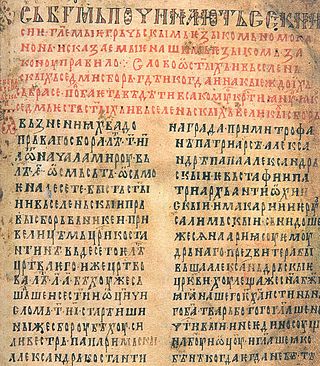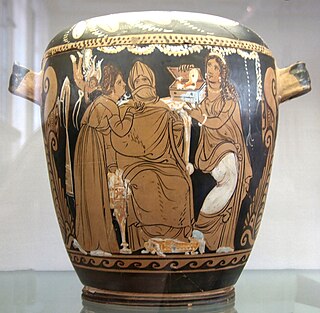
Concubinage is an interpersonal and sexual relationship between two people in which the couple does not want, or cannot, enter into a full marriage. Concubinage and marriage are often regarded as similar, but mutually exclusive.

Babylonian law is a subset of cuneiform law that has received particular study due to the large amount of archaeological material that has been found for it. So-called "contracts" exist in the thousands, including a great variety of deeds, conveyances, bonds, receipts, accounts, and most important of all, actual legal decisions given by the judges in the law courts. Historical inscriptions, royal charters and rescripts, dispatches, private letters and the general literature afford welcome supplementary information. Even grammatical and lexicographical texts contain many extracts or short sentences bearing on law and custom. The so-called "Sumerian Family Laws" are preserved in this way.
Adultery is extramarital sex partaken by a spouse, or premarital sex partaken by a betrothed person, that is considered objectionable on social, religious, moral, or legal grounds. Although the sexual activities that constitute adultery vary, as well as the social, religious, and legal consequences, the concept exists in many cultures and shares some similarities in Christianity, Judaism and Islam. Adultery is viewed by many jurisdictions as offensive to public morals, undermining the marriage relationship.
Hindu texts present diverse views on the position of women, ranging from feminine leadership as the highest goddess, to limiting gender roles. The Devi Sukta hymn of Rigveda, a scripture of Hinduism, declares the feminine energy as the essence of the universe, the one who creates all matter and consciousness, the eternal and infinite, the metaphysical and empirical reality (Brahman), the soul, of everything. The woman is celebrated as the most powerful and the empowering force in some Hindu Upanishads, Sastras and Puranas, particularly the Devi Upanishad, Devi Mahatmya and Devi-Bhagavata Purana.
The Manusmṛiti, also known as the Mānava-Dharmaśāstra or Laws of Manu, is one of the many legal texts and constitutions among the many Dharmaśāstras of Hinduism. In ancient India, the sages often wrote their ideas on how society should run in the manuscripts. It is believed that the original form of Manusmriti was changed and interpolated with commentaries and opinions of the writers rather than the original content, as many things written in the manuscript contradict each other.

The legal rights of women refers to the social and human rights of women. One of the first women's rights declarations was the Declaration of Sentiments. The dependent position of women in early law is proved by the evidence of most ancient systems.
The Algerian Family Code, enacted on June 9, 1984, specifies the laws relating to familial relations in Algeria. It includes strong elements of Islamic law which have brought it praise from Islamists and condemnation from secularists and feminists.
The Ancient Greek word oikos referred to three related but distinct concepts: the family, the family's property, and the house. Its meaning shifts even within texts.

Marriage in ancient Rome was a fundamental institution of society and was used by Romans primarily as a tool for interfamilial alliances. Roman marriage was a monogamous institution: Roman citizens could have only one spouse at a time but were allowed to divorce and remarry. This form of monogamy in Greco-Roman civilization may have arisen from the relative egalitarianism of democratic and republican city-states. Early Christianity embraced this ideal of monogamous marriage, and perpetuated it as an essential element in many later Western cultures.

A husband is a man involved in a marital relationship, commonly referred to as a spouse. The specific rights, responsibilities, and societal status attributed to a husband can vary significantly across different cultures and historical periods, reflecting a global perspective on this role.
The concept of rape, both as an abduction and in the sexual sense, makes its appearance in early religious texts.
Widow inheritance is a cultural and social practice whereby a widow is required to marry a male relative of her late husband, often his brother. The practice is more commonly referred as a levirate marriage, examples of which can be found in ancient and biblical times.

Assyrian law, also known as the Middle Assyrian Laws (MAL) or the Code of the Assyrians, was an ancient legal code developed between 1450 and 1250 BCE in the Middle Assyrian Empire. It was very similar to Sumerian and Babylonian law, although the penalties for offenses were generally more brutal. The first copy of the code to come to light, dated to the reign of Tiglath-Pileser I, was discovered in the course of excavations by the German Oriental Society (1903–1914). Three Assyrian law collections have been found to date. Punishments such as the cropping of ears and noses was common, as it was in the Code of Hammurabi, which was composed several centuries earlier. Murder was punished by the family being allowed to decide the death penalty for the murderer.

The Zakonopravilo, was the highest code in the Serbian Orthodox Church. It was finished in 1219. This legal act was written in simple language. Its basic purpose was to organize the continuation and functioning of the Serbian Kingdom and the Serbian Church. It was originally printed under the name Rules of Speech in Serbian at Raška, Serbia, in two successive issues, one for Wallachia and another for Transylvania. It is Serbia's first Serbian-language church-state constitution.

In the Sassanid Empire, the state religion Zoroastrianism created the policy that dictated relationships between men and women. Zoroastrianism set what roles women would have, the marriage practices, women's privileges in Sasanian society and influenced Islam when it arose. The moral standards, the structure of life, and the practices of the Sasanian society were found by looking at the religious writing and laws of the time. Women had legal rights, such as to own real estate, but the privileges a woman had depended on what type of wife she was, as did the restriction that were placed on her.
Adultery was a criminal offence under Chapter XX of the Indian Penal Code until it was quashed by the Supreme Court of India on 27 September 2018 as unconstitutional. The law dated from 1860. Under Section 497 of the Indian Penal Code, which was the section dealing with adultery, a man who had consensual sexual intercourse with the wife of another man without that husband's consent or connivance could have been punished for this offence with up to five years imprisonment, a fine or both. As such, the concept of adultery targeted the act of sexual intercourse occurring between a married woman and a man other than her husband, in which case the man would be guilty whereas the wife was exempt from punishment. When a married man had sexual intercourse with an unmarried woman, no party was punishable; while if a married man had sexual intercourse with a married woman other than his wife, the married man's crime was against the husband of that married woman, not against the man's own wife towards whom he had been unfaithful. Adultery was only prosecutable upon the complaint of the aggrieved husband.

Adultery in Francoist Spain and the democratic transition was a criminal offense which was defined as sexual intercourse between a married woman and a man other than her husband, and could lead to prison terms of between six months and six years. By contrast, the related crime for male infidelity was not treated the same: it was called amancebamiento and was defined as a married man keeping a mistress in the conjugal home, or keeping a mistress in a notorious manner outside the conjugal home. Adultery (adulterio) was often prosecuted, but not amancebamiento, with male infidelity being "a state of mind in Spain".

Marriage in ancient Greece had less of a basis in personal relationships and more in social responsibility. The goal and focus of all marriages was intended to be reproduction, making marriage an issue of public interest. Marriages were usually arranged by the parents; on occasion professional matchmakers were used. Each city was politically independent and each had its own laws concerning marriage. For the marriage to be legal, the woman's father or guardian gave permission to a suitable man who could afford to marry. Daughters were usually married to uncles or cousins. Wintertime marriages were popular due to the significance of that time to Hera, the goddess of marriage. The couple participated in a ceremony which included rituals such as veil removal, but it was the couple living together that made the marriage legal. Marriage was understood to be the official transition from childhood into adulthood for women.
In contemporary civil law, concubinage is a legal term that is sometimes used for an interpersonal, intimate relationship between a man and a woman, or, depending on the jurisdiction, unmarried couple, in which the couple wish to cohabit, but do not want to or cannot enter into a full marriage.










